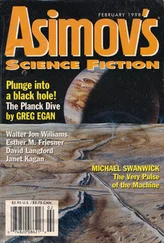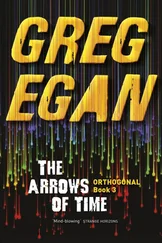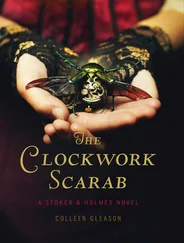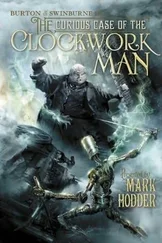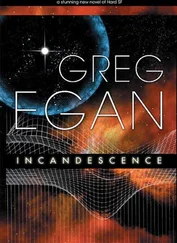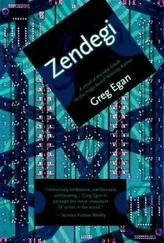Greg Egan - The Clockwork Rocket
Здесь есть возможность читать онлайн «Greg Egan - The Clockwork Rocket» весь текст электронной книги совершенно бесплатно (целиком полную версию без сокращений). В некоторых случаях можно слушать аудио, скачать через торрент в формате fb2 и присутствует краткое содержание. Жанр: Фантастика и фэнтези, на английском языке. Описание произведения, (предисловие) а так же отзывы посетителей доступны на портале библиотеки ЛибКат.
- Название:The Clockwork Rocket
- Автор:
- Жанр:
- Год:неизвестен
- ISBN:нет данных
- Рейтинг книги:3 / 5. Голосов: 1
-
Избранное:Добавить в избранное
- Отзывы:
-
Ваша оценка:
- 60
- 1
- 2
- 3
- 4
- 5
The Clockwork Rocket: краткое содержание, описание и аннотация
Предлагаем к чтению аннотацию, описание, краткое содержание или предисловие (зависит от того, что написал сам автор книги «The Clockwork Rocket»). Если вы не нашли необходимую информацию о книге — напишите в комментариях, мы постараемся отыскать её.
The Clockwork Rocket — читать онлайн бесплатно полную книгу (весь текст) целиком
Ниже представлен текст книги, разбитый по страницам. Система сохранения места последней прочитанной страницы, позволяет с удобством читать онлайн бесплатно книгу «The Clockwork Rocket», без необходимости каждый раз заново искать на чём Вы остановились. Поставьте закладку, и сможете в любой момент перейти на страницу, на которой закончили чтение.
Интервал:
Закладка:
“Those are the orthogonal stars?”
Yalda said, “Yes.”
He grimaced. “They look just like the stars back home. But now you’re saying that their worlds could kill us with a touch, if we so much as set foot on them?”
“That’s how it seems,” Yalda replied. “But then, who knows what will happen down the generations? We might even find a way to mine their rock, to render it harmless.”
Nino looked skeptical. He still found it difficult to accept that the Peerless had a future at all.
“Look at what we’ve survived already,” Yalda said. “Harder tests than any you gave us at the launch.”
“If those stars lie in the future,” he said, “why can’t you just search among them with your telescopes and see if they strike the world, or not?”
“Light from that part of their history can’t reach us here,” Yalda explained. “When we looked out at the ordinary stars, back home, we saw them as they were many years ago. The same is true of these stars—but ‘many years ago’ by our measure, now, means far from the world, far from any collision that might happen.”
“But if they continue as we see them—?”
“Then the world will end up in the thick of them,” Yalda said. “That much is clear.”
Nino was silent. Yalda said, “What we’re doing has the chance to help your children, far more than Acilio’s money ever could. Don’t you want to be a part of that?”
“It’s worth trying,” he conceded. “Better than rotting in that cell. And if you really can trust me with your own flesh—”
“Why wouldn’t I?” Yalda did her best to silence her doubts. “You’ve been a good father before. Just promise you won’t force the sagas down their throats.”
“I might tell them a couple of the old stories,” Nino said. “But the rest would be about the flying mountain whose people learned to stop time.”
He reached over and put his hand on Yalda’s shoulder. Nature dulled her fears, lulling her into a sense of rightness at the thought of what lay ahead. If she waited, if she asked for time to say her farewells, that would only make it harder. This was her last chance at the closest thing to freedom: her will, her actions, and the outcome in the world could all be in harmony.
Yalda said, “I want you to name our children Tullia and Tullio, Vita and Vito.” For all that she’d cared for Eusebio, if he was going to outlive her his name could look after itself. “If there’s a solo, call her Clara.”
Nino dipped his head in assent.
“Love them all, educate them all.”
“Of course,” Nino promised. “And you’ll be no stranger to them, Yalda. What I don’t know about you, your friends will tell them. Fatima will tell them a dozen stories of you a day.”
He’d meant to reassure her, but Yalda shivered with grief. A mountain could fly through the void, but she could not see her own children.
She fought against her sadness; if she succumbed to it now and stopped what they’d begun it would only be twice as painful the next time.
Yalda took hold of the ropes with three of her hands; with the fourth she drew Nino’s body closer. The color trails of the old stars were splayed out above them. His chest pressed against hers, innocently at first, but then their skin began to adhere. Yalda twitched, panic-stricken, picturing herself tearing free, but then she stifled her fear and let the process continue. When she looked down, a soft yellow glow could be seen passing through their conjoined flesh, its message older than writing.
Her eyelids grew heavy, and a sense of peace and reassurance suffused her thoughts. There was no need for words now. They were sharing light, and the light carried Nino’s promise to protect what she would become.
APPENDIX 1
UNITS AND MEASUREMENTS
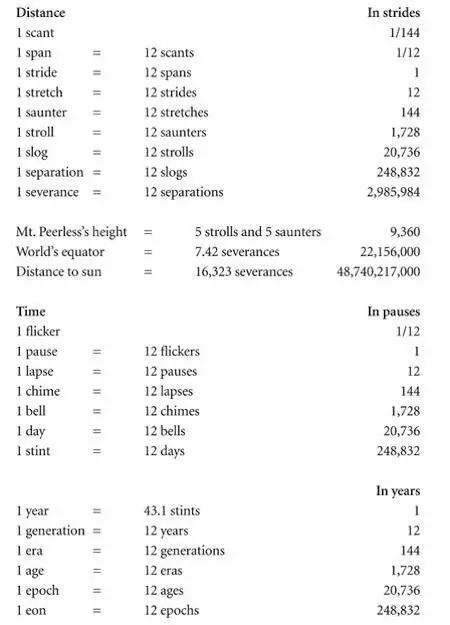
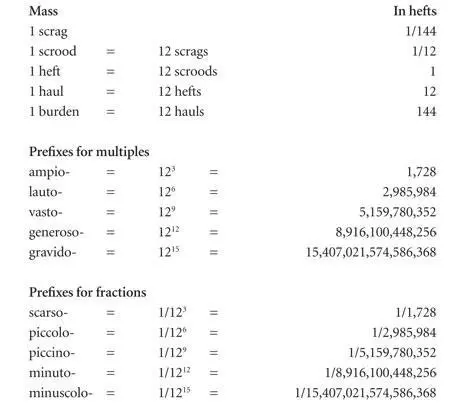
APPENDIX 2
LIGHT AND COLORS
The names of colors are translated so that the progression from “red” to “violet” implies shorter wavelengths. In the Orthogonal universe this progression is accompanied by a decrease in the light’s frequency in time. In our own universe the opposite holds: shorter wavelengths correspond to higher frequencies.
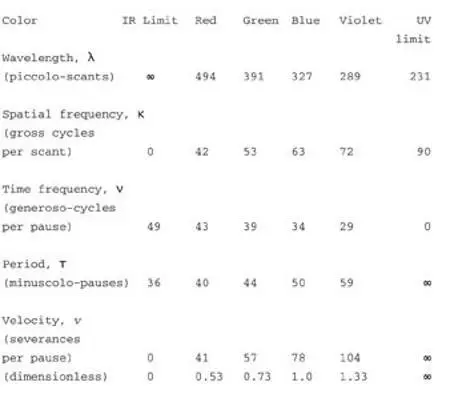
The smallest possible wavelength of light, λ min, is about 231 piccolo-scants; this is for light with an infinite velocity, at the “ultraviolet limit”. The highest possible time frequency of light, ν max, is about 49 generoso-cycles per pause; this is for stationary light, at the “infrared limit”.
All the colors of light arise from the same pattern of wavefronts, rotated into different orientations in four-space.
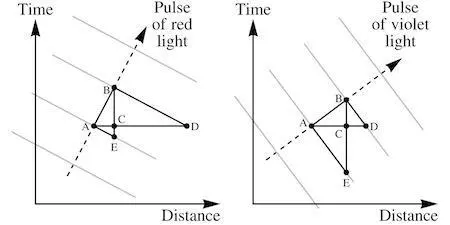
In the diagram above, AB is the separation between the wavefronts in four-space, which is fixed regardless of the light’s color. AD is the light’s wavelength (the distance between wavefronts at a given moment) and BE is the light’s period (the time between wavefronts at a fixed location).
The right triangles ACB and ABD are similar triangles , because the angles at A are the same. It follows that AC/AB = AB/AD, and:
AC = (AB) 2/AD
Also, the right triangles ACB and EAB are similar, because the angles at B are the same. It follows that BC/AB = AB/BE, and:
BC = (AB) 2/BE
Pythagoras’s Theorem, applied to the right triangle ACB, gives us:
(AC) 2+ (BC) 2= (AB) 2
Combining these three results yields:
(AB) 4/(AD) 2+ (AB) 4/(BE) 2= (AB) 2
If we divide through by (AB) 4we have:
1/(AD) 2+ 1/(BE) 2= 1/(AB) 2
Since AD is the light’s wavelength, 1/AD is its spatial frequency, κ, the number of waves in a unit distance. Since BE is the light’s period, 1/BE is its time frequency, ν, the number of cycles in a unit time. And since AB is the fixed separation between wavefronts, 1/AB is the maximum frequency of light, ν max, the frequency we get in the infrared limit when the period is AB.
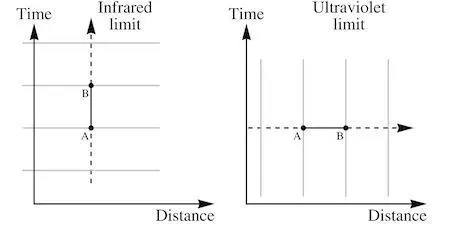
So what we’ve established is that the sum of the squares of the light’s frequencies in space and in time is a constant:
κ 2+ ν 2= ν max 2
This result assumes that we’re measuring time and space in identical units. But in the table above we’re using traditional units that pre-date Yalda’s rotational physics. The data Yalda gathered on Mount Peerless showed that if we treat intervals of time as being equivalent to the distance blue light would travel in that time, the relationship between the spatial and time frequencies takes the simple form derived above. So the appropriate conversion factor from traditional units to “geometrical units” is the speed of blue light, v blue , and we have:
( v blue × κ) 2+ ν 2= ν max 2
The values in the table are expressed in a variety of units that have been chosen so that the figures all have just two or three digits. When we include a factor to harmonise the units, the relationship becomes:
(78/144 × κ) 2+ ν 2= ν max 2
Now, the velocity, v , of light of a particular color is simply the ratio between the distance the light travels and the time in which it does so. If we take the pulses of light in our first diagram, they travel a distance AC in a time BC, giving v = AC/BC. If we then use the relationships we’ve found between AC and AB and the spatial frequency κ, and between BC and BE and the time frequency ν, we have:
Читать дальшеИнтервал:
Закладка:
Похожие книги на «The Clockwork Rocket»
Представляем Вашему вниманию похожие книги на «The Clockwork Rocket» списком для выбора. Мы отобрали схожую по названию и смыслу литературу в надежде предоставить читателям больше вариантов отыскать новые, интересные, ещё непрочитанные произведения.
Обсуждение, отзывы о книге «The Clockwork Rocket» и просто собственные мнения читателей. Оставьте ваши комментарии, напишите, что Вы думаете о произведении, его смысле или главных героях. Укажите что конкретно понравилось, а что нет, и почему Вы так считаете.


